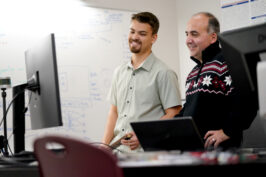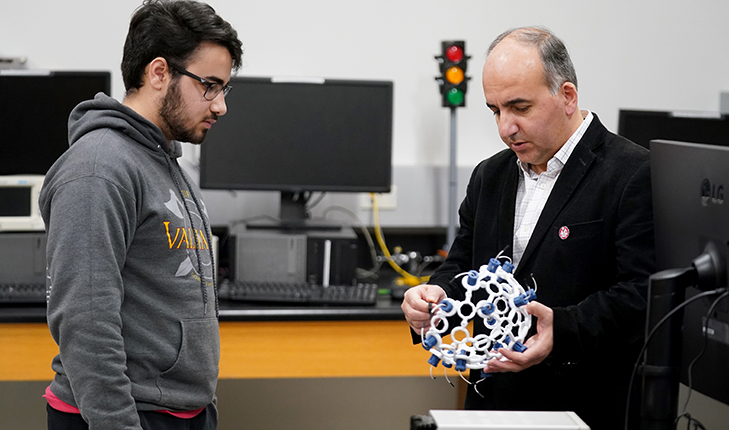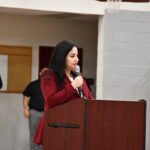Skip to content
From smart robot to prosthetic technology, engineering research fuels new innovations
Faculty from the Lyles College of Engineering at Fresno State are making research breakthroughs with local and global impacts.
Dr. Hovannes Kulhandjian, associate professor of electrical and computer engineering, received a patent for his invention, “System and Method for Human and Animal Detection in Low Visibility,” a handheld device that can be used by firefighters to find humans and animals in heavy smoke during emergency situations.
“Receiving the ‘Notice of Allowance’ from the U.S. Patent Office was an exhilarating moment,” Kulhandjian said. “We filed for a patent back on May 12, 2021, and after nearly three years of anticipation, having it approved for a patent is truly gratifying. This marks my inaugural patent application, and the validation of its acceptance is incredibly rewarding.”
The invention started as a senior design project with three students and continued to evolve into its current form. The device uses an infrared camera and a radar sensor to process data and relay relevant classification and identification of objects of interest in real time.
Kulhandjian received the 2023-24 Provost Award for Distinguished Achievement in Research, Scholarship or Creative Accomplishment for this and several other successful research endeavors.
Following the successful patent approval, Kulhandjian plans to advance the commercialization of the invention by developing a fully functional prototype and seeking partnerships with companies or organizations interested in mass production and commercialization of the product.
“This patent holds profound significance for both Fresno State and the students who contributed to its development,” Kulhandjian said. “By tackling a critical challenge faced by firefighters in search and rescue operations, particularly in environments with heavy smoke, this invention showcases the university’s commitment to innovation and societal impact. It not only enhances the safety and efficiency of firefighting activities but also underscores the university’s role as a leader in cutting-edge technology with real-world applications.”
His long-term goal is to see this invention deployed widely, making a tangible difference in firefighting practices globally. He aims to ensure this groundbreaking technology reaches those who need it most, ultimately saving lives and safeguarding communities from the dangers of fire-related incidents.
The patent application can also be applied in military settings, particularly during search and rescue operations in environments filled with heavy smoke following an explosion.
CrossBot invention
 Over the summer, Kulhandjian’s CrossBot invention made national and international headlines with significant media attention in Germany, China, Italy, Iran, Japan, Russia and several other countries.
Over the summer, Kulhandjian’s CrossBot invention made national and international headlines with significant media attention in Germany, China, Italy, Iran, Japan, Russia and several other countries.
The CrossBot is a smart robot that implements advanced machine learning algorithms for real-time detection of vehicles, pedestrians and cyclists. These algorithms leverage data from video cameras to assess road conditions and guide those on foot safely through intersections.
The idea for CrossBot originated when the principal at the school of Kulhandjian’s children sent an email to parents requesting volunteers to help ensure students’ safety at crosswalks, due to a shortage of crossing guards.
“This robot is not limited to just schools, it can also be used to help more vulnerable populations like the visually impaired and elderly cross the road,” Kulhandjian said.
He plans to continue the development of the CrossBot and file for a patent.
Prosthetic arm control technology
Additionally, Kulhandjian, in collaboration with Dr. Anahit Hovhannisyan from the Biology Department, is developing a prosthetic arm control using Brain-Computer Interface, which utilizes a noninvasive electroencephalography-based approach to allow patients with amputated arms to control a prosthetic arm through intuitive and precise motor commands derived from neural signals.
The research aims to create a system capable of interpreting EEG patterns associated with motor intention and translating them into real-time prosthetic arm movements. This non-invasive method eliminates the need for implants, enhancing accessibility while reducing potential health risks.
“It’s rewarding to see the hard work pay off,” Kulhandjian said. “The late nights and sleepless hours weren’t in vain, and it’s even more fulfilling to witness the success of the students who’ve collaborated with me on these projects.”
Faculty from the Department of Civil and Geomatics Engineering are also exploring the use of new technologies in their work.
Dr. Xiangxiong Kong, assistant professor of civil engineering, received a patent for his research in fatigue crack detection in civil infrastructure before he began teaching at Fresno State.
Dr. Kong is currently working on researching how to better design a virtual reality module for the purpose of civil structural inspection.
“I am working with a faculty member from the College of Arts and Humanities, and they are bringing a very innovative perspective regarding how to improve the design of this module,” Kong said. “We hope by next spring semester we can invite student participants to assess its effectiveness.”
In August, Kong received a $49,996 grant from NASA for his project, “Human-Centric Digital Twins in NASA Space Missions.” Using his background in modeling and remote sensing applications in the civil engineering domain, he will work with other researchers to solve NASA’s space missions.
NASA awarded $1.2 million to 23 minority-serving institutions to collaborate on research projects and contribute to the agency’s missions for the benefit of humanity. In addition to research, awarded institutions will be trained and prepared for larger funding programs within NASA.
The award follows a period of research growth at the university. Fresno State was awarded 434 grants and contracts during the 2023-24 academic year for a total of $78.3 million, setting a research and grant funding record for the sixth consecutive year.
“Research is a critical component of what we do as faculty and we are also providing an advanced research experience for students,” Kong said. “If you have an innovation that has patent potential, that also gives students a very authentic taste of what they can do in the industry so we must continue pushing forward in research.”
Share This Story, Choose Your Platform!












